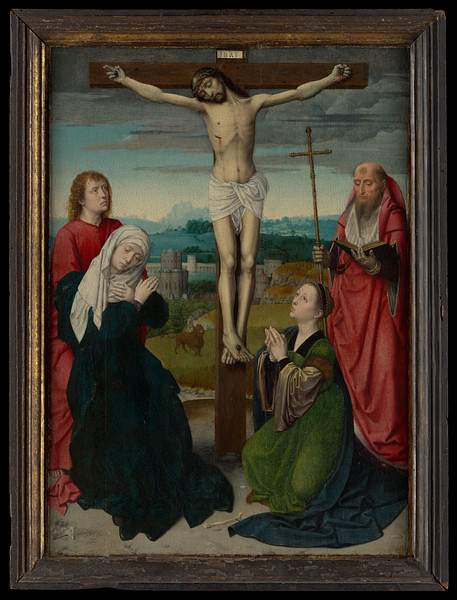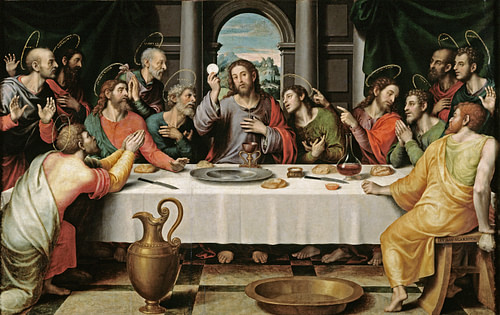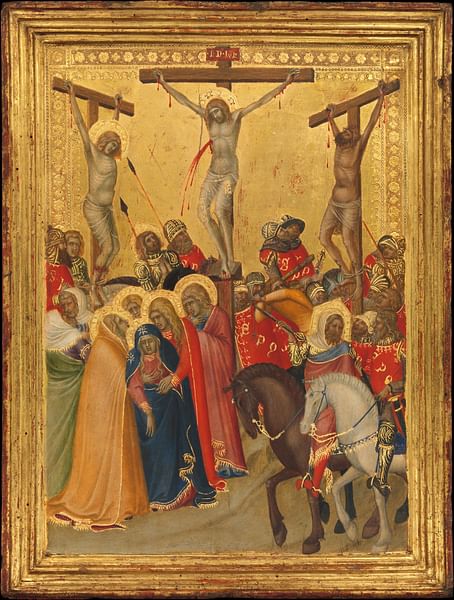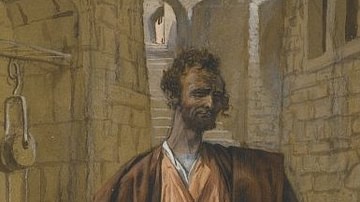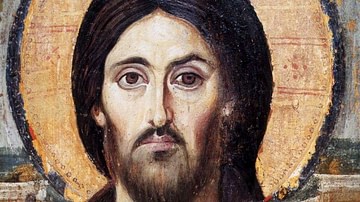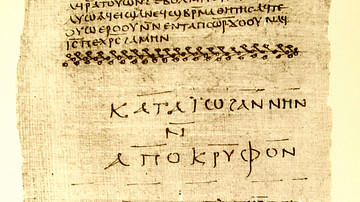The central pillars of Christianity originate from the story of the trial, crucifixion, and death of Jesus Christ. The events cover the time when Jesus of Nazareth and his followers entered Jerusalem for the festival of Passover to Sunday morning when his followers proclaimed that he had been raised from the dead.
In Christian theology and liturgy, this story is known as "The Passion Narrative," from one meaning of the Latin term pasio, "to suffer." The story comprises Holy Week, from Palm Sunday to Easter Sunday. Every year during this week, thousands of Christian pilgrims re-enact the events by literally tracing the footsteps of Jesus along a street in Jerusalem known as the Via Dolorosa, "the way of suffering." Each place that tradition associates with a specific event is known as a Station of the Cross. The route begins on a site where Jesus was condemned by Pilate and ends at the Church of the Holy Sepulcher (the site claimed to house the tomb of Jesus by Catholics and several Eastern Orthodox communities). The art of the Renaissance (and beyond) became dominated by images of scenes from The Passion.
The Gospel Accounts
All the details concerning the events of the last days of Jesus are found in the canonical gospels of the New Testament: Mark, Matthew, Luke, and John. Beginning with Mark (the first written gospel, c. 70 CE), the story is then repeated in Matthew and Luke. John's gospel has a different structure but also contains the basic story. While the gospels agree on many details, nevertheless, there are differences in details as well as additions to Mark's story.
The gospels described the ministry of Jesus (mostly in the region of the Galilee), teaching that "the kingdom of God" was at hand (the final intervention of God in "the final days," as found in the books of the Prophets). While preaching, Jesus performed miracles and exorcisms ("driving out demons"). The gospels then relate that Jesus and his disciples went to Jerusalem to celebrate the Passover festival.
The Chronology of “The Passion”
Palm Sunday
Passover was a yearly celebration of the Jews' liberation from slavery in Egypt. Thousands of Jewish pilgrims crowded the city for this festival every year. Jesus and the disciples were staying with friends in the village of Bethany, located on the eastern side of the Mt. of Olives. Jesus tells his disciples where to find a donkey and he proceeds to enter Jerusalem this way. Their entrance is met with rejoicing and exaltation from the crowd. Breaking off palm branches and waving them is what gives this day its name. The crowd welcomes Jesus as "the son of David," and "king of the Jews." (The "son of David" reference is to the tradition that God would "raise up" someone from the line of King David to rule. David was "anointed" by the Prophet Samuel and the Hebrew term for "anointed" is "messiah.")
The entrance of Jesus into the city is always described as a "triumph," in the shared cultural tradition of the way in which kings (and now the Roman emperor) entered a city. The gospels also proclaim this as a "fulfillment of prophecy" in reference to Zechariah 9:9: "Behold, your king comes to you, humble and mounted on an ass." By tradition, the messiah appears from the east, the Mt. of Olives.
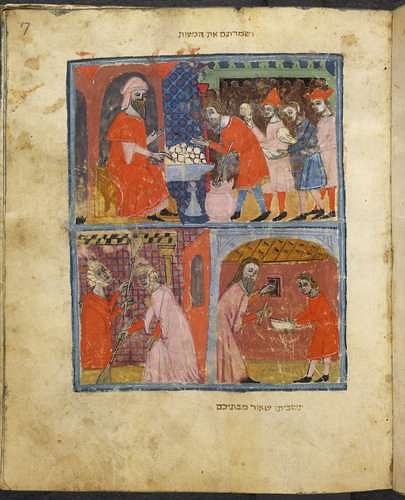
We cannot verify if this took place on a Sunday. Jewish Law required that no one could participate in the Passover if they had entered "corpse contamination" during the previous year. This required "sprinklings" of holy water at the Temple every few days leading up to the holiday, so everyone came about a week earlier.
The Temple Incident
The first three gospels report that as soon as Jesus entered the city he went to the Temple complex, overturned the tables of the money-changers and the animal sellers, claiming, "My house shall be a house of prayer (for all the nations, so Mark), but you have made it a den of thieves." (John placed this scene earlier in his narrative). According to the general understanding, first proposed by Mark, this event leads directly to the condemnation of death for Jesus. "Destroy this Temple and in three days I will raise it up." (John 2:19)
Oddly, for the next few days, the gospels report that Jesus returned to the Temple in the next few days and taught there. This is actually a narrative device required of the plot; the writers are filling in time, until the first night of Passover.
Holy Thursday
In the first three gospels, Jesus and the disciples celebrate the first night of Passover in a ritual meal known as the Seder ("order of things"). John changes this to a regular meal on Wednesday night. The Jewish reckoning of the day was from sunset to sunset. During the day before the Seder, thousands of lambs were slaughtered in the Temple for the ritual meal. John connected these sacrifices to the death of Jesus, "the lamb that was sacrificed." John adds a story that Jesus washed the feet of his disciples (as a symbol of true service). This ritual is re-enacted in churches on Holy Thursday, often by the clergy as a sign of humility.
The Last Supper
The recreation of this meal became a central tenet of Christian worship (and one of the sacraments in Catholicism and Orthodox communities). During the meal, Jesus recites the ritualistic words, "This is my body, this is my blood . . . do this in remembrance of me." We know that this was a ritualistic formula and re-enactment from Paul, where he recites the formula verbatim in 1 Corinthians.
The Last Supper is referred to interchangeably as the Eucharist (Greek for a “thanksgiving”) and later, communion. It is at this meal that Jesus informed the disciples that one of them will betray him. Judas Iscariot secretly informs the Jewish leadership where they can find Jesus that night to arrest him. Selling Jesus out for "thirty pieces of silver" is a reference to Psalm 41:9.
The Agony in the Garden
After dinner, Jesus and the disciples go over to the foot of the Mt. of Olives, known as Gethsemane. This is not a garden, but an olive press. Jesus asked the disciples to stay awake and watch with him while he prayed (although he has to wake them three times). His prayer to God is known as an "agony," as foreseeing what is to come, he asks God to help him to avoid it. We hear no response from God, but Jesus accepts his fate.
The Arrest
The gospels vary in the details as to who arrests Jesus: the Temple guards, the Jewish leaders, the Roman auxiliaries (so John), or even just the mob? Judas betrays Jesus with a kiss. In later Christian tradition Judas is condemned for eternity to share the center of Hell with Satan; see Dante's Inferno. The disciples react with a sword, cutting off the ear of a slave, but Jesus restores the wound and tells them to put away their swords. The disciples, now in a panic, scatter and abandon Jesus, fulfilling what he had predicted they would do.
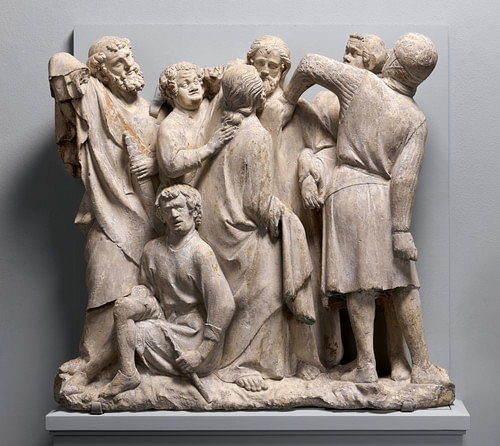
There are differences as to where they take Jesus: to the Council, the Sanhedrin or ruling body (Mark), or the house of the high-priest (John). Peter remains outside. When he is accused of being a follower, he denies knowing Jesus three times, as predicted.
The Jewish Trial(s)?
Again, variation and confusion in the gospels: one trial at night, two trials at night, one at night, one in the morning, two in the morning? Luke includes a separate trial in front of Herod Antipas (in town for Passover) because Jesus was technically from his tetrarchy. The Jewish trial is tied to the alleged claims of Jesus, "destroy this Temple and in three days I will raise it up." Mark claimes this trial was illegal because the witnesses could not agree.
The denouement is reached when Jesus, reticent until now, responds to the high-priest's question: "Are you the blessed one, the messiah?" Jesus admits that he is and that he is also "the son of man" who will come in glory when god's kingdom is established, to judge all humanity. With signs of mourning, the high-priest declares this as blasphemy and condemns him to death.
The Trial Before Pontius Pilate
Claiming that the Jewish Council could not administer the death penalty under Roman provincial law, Jesus is sent to Pontius Pilate, the Roman procurator for Judea. In Luke's gospel, Jesus is charged with telling the Jews not to pay taxes to Rome (which is patently false according to Luke's story). In John's gospel, Jesus is condemned because of the growing crowds over his raising of Lazarus - the high-priest in John claims that the Jews should get rid of Jesus before Rome can step in - that one man should die for the sake of the nation.
In all four gospels, Pilate is portrayed as reluctant to execute Jesus. He attempts to avoid the decision by offering to release another prisoner, Barabbas, and threw a sop to the (now) anti-Jesus mob by letting them decide. The crowd cries, “Give us Barabbas,” and Jesus is condemned to death for rebellion against Rome. Matthew (27:24) said that Pilate literally “washed his hand” of the affair.
Good Friday
Friday morning Jesus is scourged in the Antonia Fortress where soldiers mock him by giving him a crown of thorns. They place a cross-beam on him (not the entire cross) to carry to the execution grounds located outside the city walls (the hill of Calgary). In keeping with Roman law, the gospels report that a public plaque stating the charge was attached, "Jesus of Nazareth, king of the Jews." This was the charge of treason against Rome which always resulted in the punishment of crucifixion.
The Suffering & Death of Jesus
Especially in Mark, Jesus suffers incredible tortures. Mark incorporates Psalms of lament and references to the “suffering servant” passages in Isaiah (symbolizing disasters that occurred to the nation). Mark's Jesus cried out in agony, "My God, my God, why have you forsaken me?" (15:34) Luke is the only gospel that claims that Jesus forgave his tormentors from the cross. On the other hand, John's Jesus (a pre-existent man from heaven), does not suffer. In John (19:30), the last words are: "It is accomplished" (referring to what he came to earth to do).
Mark, Matthew, and Luke claim that the only witnesses to the crucifixion were the women followers of Jesus who watched from afar. John has "the beloved disciple" and Mary, the mother of Jesus at the foot of the cross. "The beloved disciple" by tradition is allegedly John, the brother of James.
Jesus died in a few hours. At his death, the gospels report that a Roman centurion declared: "Truly this was god's son." (Matthew 27:54) It is only in John's gospel that a soldier, wanting to make sure that Jesus was dead, pierced his side with a spear. As sunset was near and Sabbath about to begin, Jesus's body was claimed by Joseph of Arimethea and laid in his family tomb, although the funeral rituals were not yet completed.
Easter Saturday
It is only in later Christian tradition that speculation on what Jesus was doing (and where he was) in the interim between Friday night and Sunday morning began. Scholars debate the date of an early manuscript known as The Gospel of Peter, which sets up some of the details that will later become incorporated into what is known as the Harrowing of Hell. ("Harrowing" is an Anglo-Saxon term for a "raid.") Easter Saturday is now part of the liturgy for Holy Week, claiming that this is when Jesus descended into Hell (a line from the Nicene Creed) on Saturday. While there, he fought with Satan for the souls of the righteous dead (famous pagans, the patriarchs of the Bible, etc.) and released their souls when he emerged from the tomb.
Easter Sunday
On Sunday morning, the women followers of Jesus go to the tomb to finish the funeral rituals. They find the stone sealing the tomb rolled back and find it empty. In Mark, an angel tells them to tell the disciples to meet him in the Galilee (but the women told no one because they were terrified according to the original ending of Mark). Matthew has the risen Jesus commanding the disciples to preach in his name. Luke and John add several resurrection appearances that include scenes of Jesus eating food (he was not a ghost).
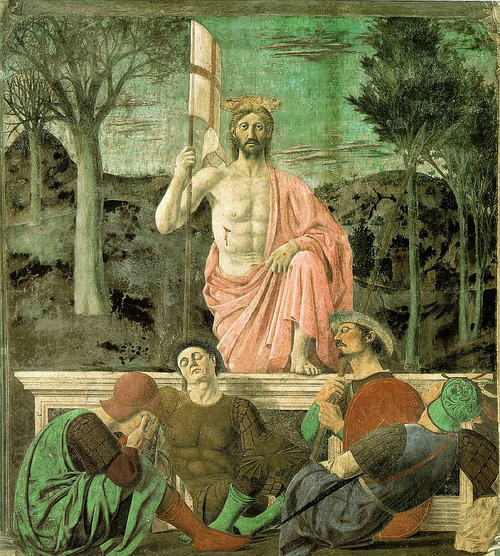
The Ascension
Only the gospel of Luke has the bodily ascension of Jesus to heaven. He utilizes a tradition by the 1st century CE that Moses had walked up into a cloud and was taken to heaven from a mountain top. The traditional site for this event is found on the top of the Mt. of Olives.
However, in Luke's sequel to his gospel, the Book of Acts, Jesus remains on earth for 40 days, teaching the disciples about the "kingdom." After his ascension in this version, "the spirit of God" is poured out on the disciples who had remained in Jerusalem for the next holiday, Pentecost. Christians combine these two events: the Ascension is celebrated forty days after Easter, while Pentecost (now understood as the birthday of the church) is celebrated the following Sunday.
